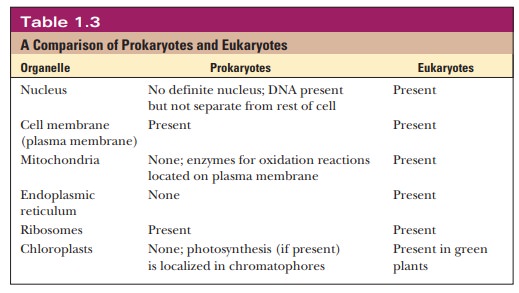Chapter: Biochemistry: Biochemistry and the Organization of Cells
The Biggest Biological Distinction-Prokaryotes and Eukaryotes
The Biggest Biological
Distinction-Prokaryotes and Eukaryotes
All cells contain DNA. The
total DNA of a cell is called thegenome.Individualunits
of heredity, controlling individual traits by coding for a functional protein
or RNA, are genes.
The
earliest cells that evolved must have been very simple, having the minimum
apparatus necessary for life processes. The types of organisms living today
that probably most resemble the earliest cells are the prokaryotes. This word, of Greek derivation (karyon, “kernel, nut”), literally means “before the nucleus.” Prokaryotes
include bacteria and cyanobacteria. (Cyanobacteria were
formerly called blue-green algae; as the newer name indicates, they are more
closely related to bacteria.) Prokaryotes are single-celled organisms, but
groups of them can exist in association, forming colonies with some
differentiation of cellular functions.
What is the difference between a prokaryote and a eukaryote?
The word
eukaryote means “true nucleus.” Eukaryotes are more complex organ-isms
and can be multicellular or single-celled. A well-defined nucleus, set off from
the rest of the cell by a membrane, is one of the chief features
distinguish-ing a eukaryote from a prokaryote. A growing body of fossil
evidence indicates that eukaryotes evolved from prokaryotes about 1.5 billion
(1.5 × 109) years ago, about 2 billion years after life first appeared on
Earth. Examples of single-celled eukaryotes include yeasts and Paramecium (an organism frequently
discussed in beginning biology courses); all multicellular organisms (e.g.,
animals and plants) are eukaryotes. As might be expected, eukaryotic cells are
more complex and usually much larger than prokaryotic cells. The diameter of a
typical prokaryotic cell is on the order of 1 to 3 µm (1 × 10–6 to 3 ×
10–6 m), whereas that of a typical eukaryotic cell is about 10 to 100
µm. The distinction between prokaryotes and eukaryotes is so basic that it is
now a key point in the classification of living organ-isms; it is far more important
than the distinction between plants and animals.
The main
difference between prokaryotic and eukaryotic cells is the exis-tence of
organelles, especially the nucleus, in eukaryotes. An organelle is a part of the cell that has a distinct function; it is
surrounded by its own membrane within the cell. In contrast, the structure of a
prokaryotic cell is relatively simple, lacking membrane-enclosed organelles.
Like a eukaryotic cell, however, a prokaryotic cell has a cell membrane, or
plasma membrane, separating it from the outside world. The plasma membrane is
the only membrane found in the prokaryotic cell. In both prokaryotes and
eukaryotes, the cell membrane consists of a double layer (bilayer) of lipid
molecules with a variety of proteins embedded in it.
Organelles
have specific functions. A typical eukaryotic cell has a nucleus with a nuclear membrane. Mitochondria (respiratory organelles) and an inter-nal membrane
system known as the endoplasmic reticulum
are also common to all eukaryotic cells. Energy-yielding oxidation reactions
take place in eukaryotic mitochondria. In prokaryotes, similar reactions occur
on the plasma mem-brane. Ribosomes
(particles consisting of RNA and protein), which are the sites of protein
synthesis in all living organisms, are frequently bound to the endo-plasmic
reticulum in eukaryotes. In prokaryotes, ribosomes are found free in the
cytosol. A distinction can be made between the cytoplasm and the cytosol. Cytoplasm refers to the portion of the
cell outside the nucleus, and the cytosol
isthe aqueous portion of the cell that lies outside the membrane-bounded
organ-elles. Chloroplasts, organelles
in which photosynthesis takes place, are found in plant cells and green algae.
In prokaryotes that are capable of photosynthesis, the reactions take place in
layers called chromatophores, which
are extensions of the plasma membrane, rather than in chloroplasts.
Table 1.3 summarizes the basic differences between prokaryotic and eukaryotic cells.

Summary
All
cells contain DNA and are separated from their environment by a cell membrane.
Prokaryotic cells do not have significant internal membranes, but the larger
cells of eukaryotes have an extensive membrane system. The internal membranes
mark off the organelles, portions of the cell with a specific function.
Related Topics